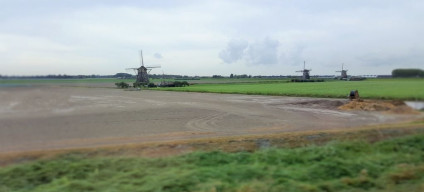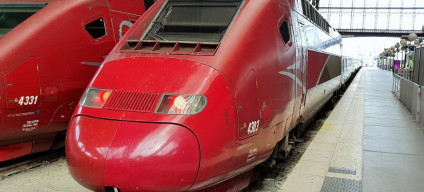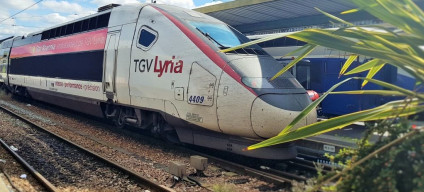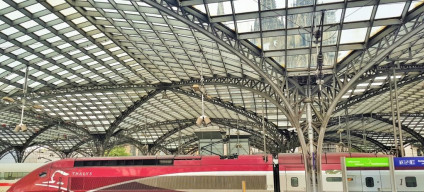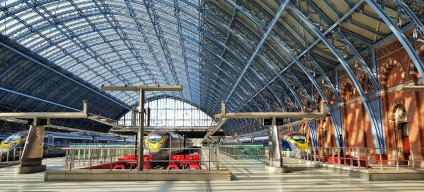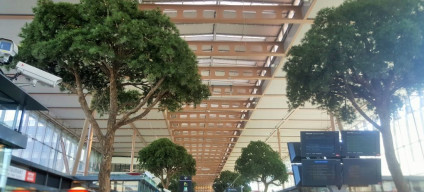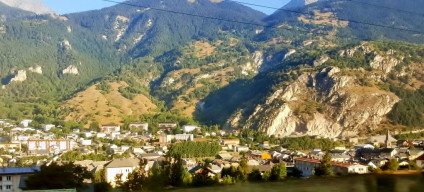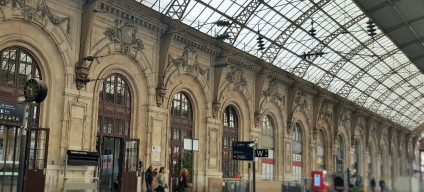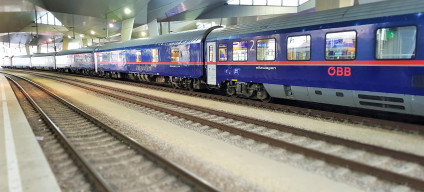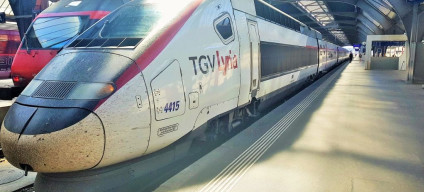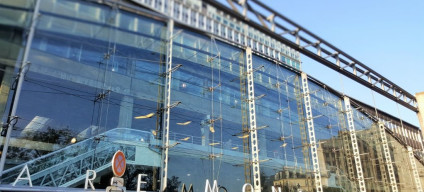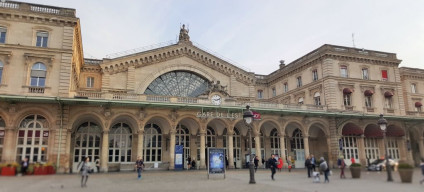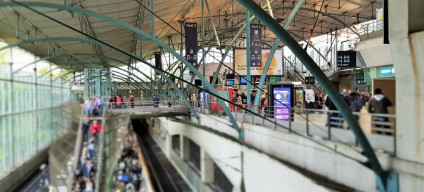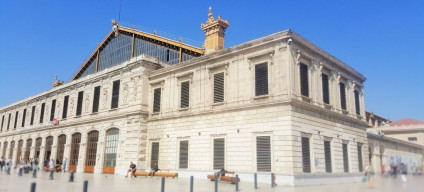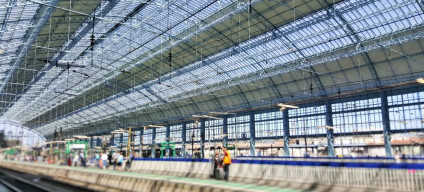Related Content
Content
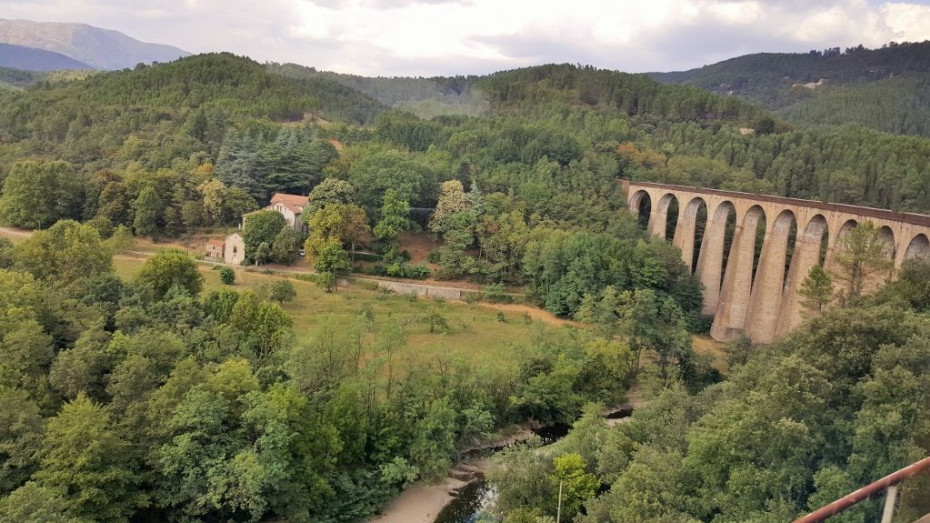
France by train
Welcome to the guide on how to save money, time and confusion when travelling in France by train.
Share
Travelling on French trains can be an exhilarating experience, and once you’re used to the many quirks of national rail operator SNCF, it can be less complicated then it first seems.
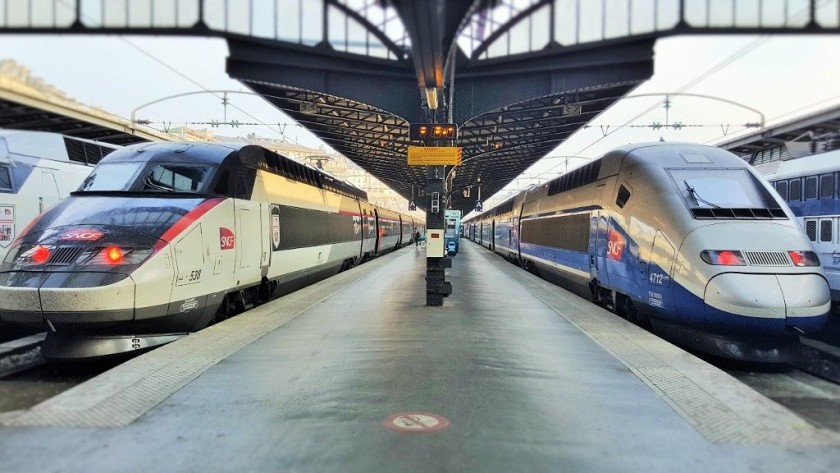
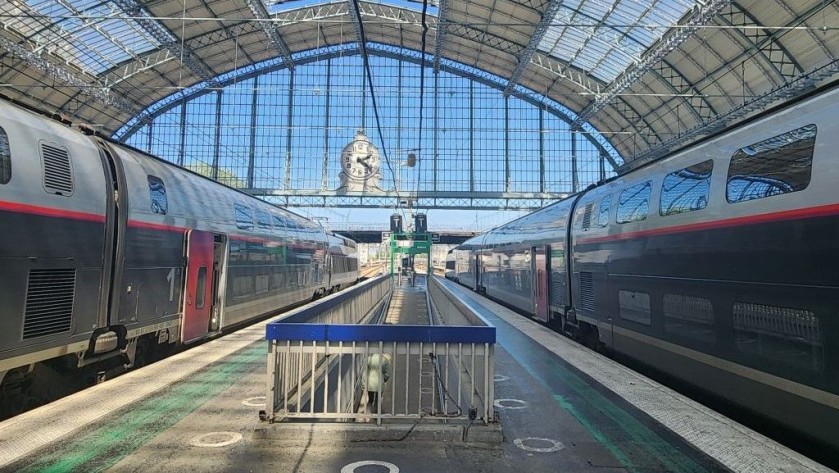
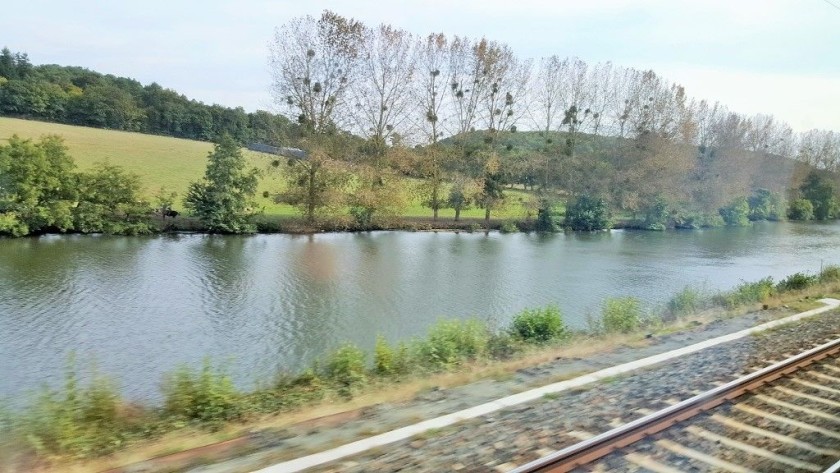
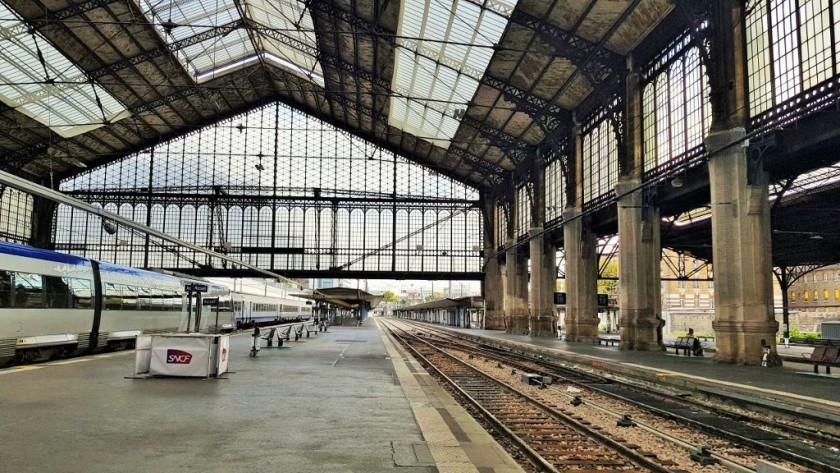
Helpful Links:
The 19 Things Most Worth Knowing...
These are the 19 things that are particularly useful to know about French rail travel:
- The French national rail operator is SNCF and it manages virtually all train services in France.
- Most French cities are served by high speed rail lines on which trains travel at up to 300 km/h, but those which aren't include Caen, Clermont-Ferrand, Le Havre, Limoges and Rouen.
- On most of the high speed routes there is a choice between a regular InOui service, or a typically cheaper, but more basic Ouigo service - TGV trains are used for both.
- These TGV trains can travel beyond the high speed lines to serve cities that include Brest, Nice, Perpignan and Toulouse.
- Intercités are the long-distance express trains which don't use the high-speed lines and they primarily operate on these routes:
- Paris - Nevers - Vichy - Clermont-Ferrand
- Paris - Limoges - Toulouse
- Marseille - Nimes - Montpellier - Toulouse - Bordeaux
- Nantes - Bordeaux
- Nantes - Bourges - Lyon
- The timetables on long-distance French rail routes are typically irregular, aside from Paris ↔ Lille and Lyon, the express train routes don't typically have hourly departures.
- It can pay off to be as flexible as possible re: departure and arrival times, it is unknown for there to be price differences of more than €50 on different departures on the exact same route and day.
- Seat reservations are complimentary and are therefore included when booking tickets for a journey by an express train - InOui, Intercités Nomad and Ouigo.
- It's not uncommon for all seats to be sold out on specific InOui services ahead of the day of departure, particularly when heading to holiday destinations - During July and August 2023 around 40% of InOui services were fully booked prior to departure.
- The local and regional trains are known as TER services, but if you book the cheapest type of ticket for last minute travel at a station, you can only travel by these trains and cannot board any of the express services.
- TER trains depart at least hourly on routes around Lyon, Nice, Metz and Lille, but gaps of two hours or more between departures are fairly common on other routes.
- All international daytime trains to and from Paris are high-speed services:
- Eurostar - to/from London, Amsterdam, Brussels and Cologne
- TGV and ICE - to/from Frankfurt and Stuttgart
- Lyria - to/from Basel, Geneva, Lausanne and Zurich
- TGV and Frecce trains - to/from Milan and Turin
- TGV trains - to/from Barcelona.
- AVE trains - to/from Barcelona and Madrid
- Overnight trains, which convey couchettes, but not sleeping cabins, connect Paris to destinations in southern France including Nice and Perpignan.
- At major French stations, the voie (platform / track) that each train will be leaving from will appear on the departure screens around twenty minutes prior to departure. (30 mins when taking Ouigo services)
- The departure info shows where to wait for easy boarding into the coaches of the TGV and Intercités train in which reserved seats will be located.
- When available the elevators / ascenseurs on the platforms / voies at the larger stations tend to be only available for require assistance and therefore can't use the stairs.
- The centre of Paris is surrounded by multiple stations used by long-distances trains to / from different destinations.
- Est = trains to/from Berlin, Colmar, Frankfurt, Luxembourg, Metz, Nancy, Reims, Strasbourg and Stuttgart -plus the Nightjet trains
- Lyon = trains to/from Antibes, Avignon, Basel, Barcelona, Cannes, Dijon, the French Alps, Geneva, Grenoble, Marseille, Milanm Montpellier, Mulhouse, Nice, Nimes, Turin, Valence and Zurich
- Montparnasse = trains to/from Biarritz, Bordeaux, Brest, La Rochelle, Le Mans, Nantes, Poitiers, Rennes and Toulouse
- Nord = trains to/from Amsterdam, Brussels, Calais, Cologne, Lille and London
- St Lazare = trains to/from Bayeux, Caen, Cherbourg, Le Havre and Rouen
- Transferring between the different stations in Paris can often be avoided by taking InOui and Ouigo services which use routes which circle around the capital and provide direct links, such as:
- Lille ↔ Bordeaux, Lyon, Marseille, Montpellier, Nantes, Rennes and Strasbourg.
- Nantes and Rennes ↔ Lyon, Marseille and Strasbourg
- Bordeaux ↔ Strasbourg.
- The French rail network is Paris-centric, so when travelling cross-country between cities along different routes from and to the capital, the train services are much less frequent.
For example, Lyon has two trains per hour to Paris, but the typical service to other cities from Lyon is only:
- Bordeaux = 0 trains
- Nancy = 1 x train
- Nantes = 6 x trains
- Rennes = 3 x trains
- Rouen = 1 x train
- Strasbourg = 4 x trains
- Toulouse = 3 x trains
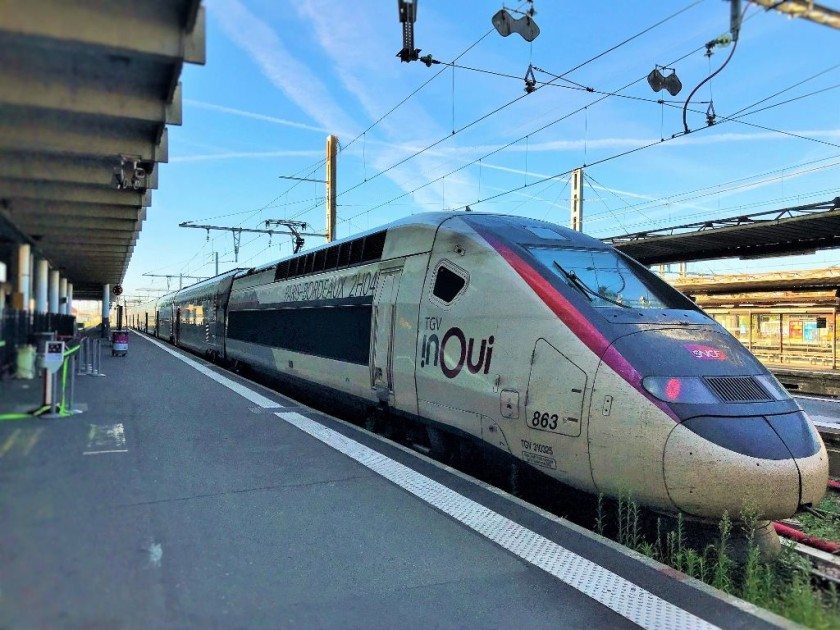
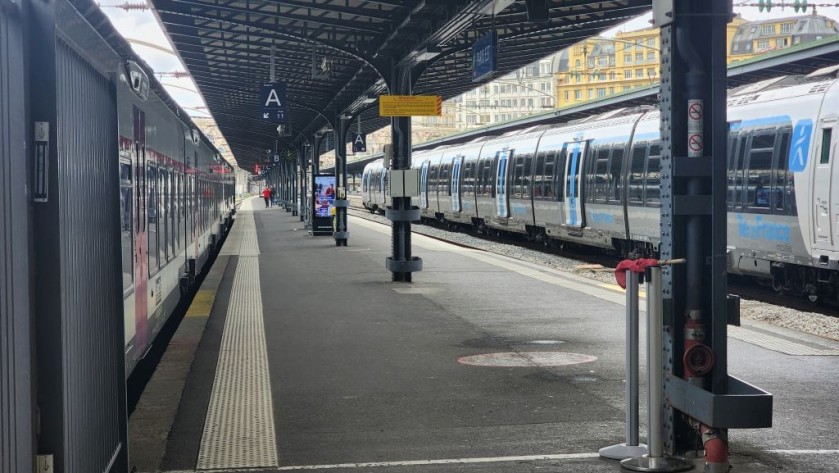
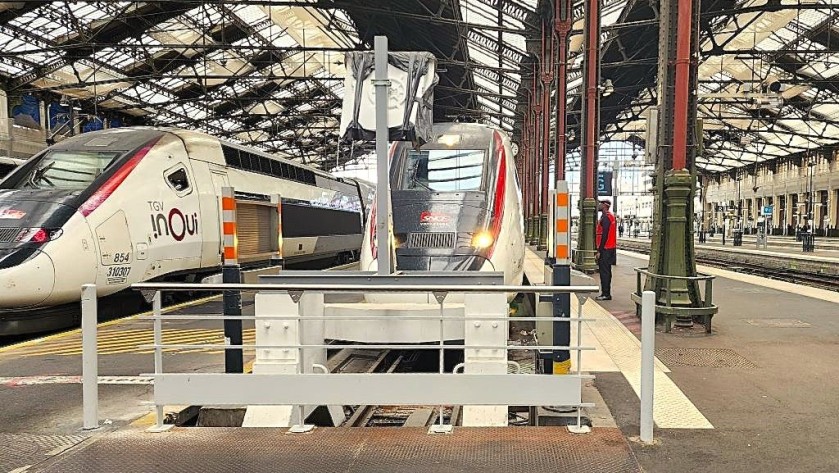
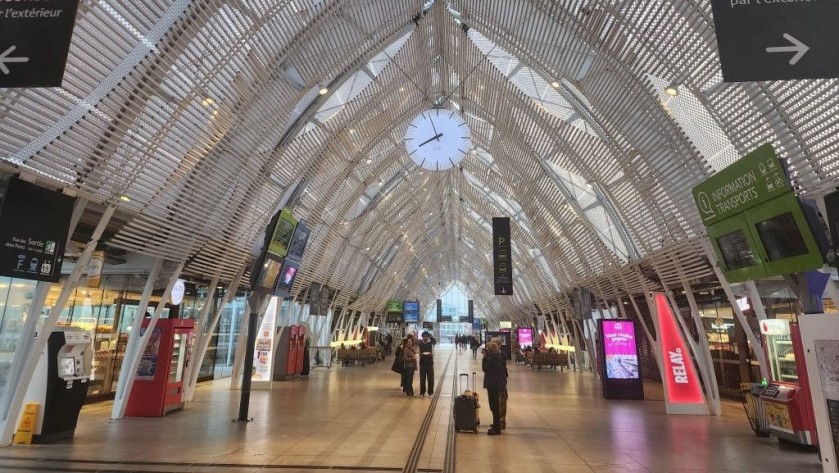
Travelling on the trains:
SNCF is the national rail operator in France and it provides virtually all French train services, which are grouped into these five categories
(1) TGV InOui = standard (superior) TGV services, which use the high speed lines for all or most of their journeys.
(2) Ouigo - More basic lower cost TGV services, which provide an alternative to the TGV InOui services on the high speed lines.
(3) Intercités = Express train services which don't use the high speed lines.
Cities which are only served by Intercités trains include Clermont-Ferrand and Limoges.
(4) TER services = The regional train services in France, but this encompasses a broad swathe of services including;
- trains that can spend more than two hours travelling between cities; and some of these routes can parallel the high speed lines;
- the local trains outside Paris.
(5) Transilien services = the longer distance 'commuter' trains to/from Paris.
(The RER trains which travel across central Paris are co-operated between SNCF and RATP, which also operates the Paris Metro).
All on board announcements on domestic trains are French language only.
The conductors may not speak English on IC and TER trains, particularly those that don’t serve Paris.
taking a TGV service
There are four* different types of regular TGV train, which travel on the TGV InOui routes.
You can check which of these TGV trains will be used on a departure you will be taking by following these simple steps.
*Technically there are more than 4 types of TGV train, but we have focused on the four trains, that will have obvious differences in the on-board experience.
The Ouigo Services:
However, on most the high-speed routes, travellers now have a choice between travelling on standard TGV InOui service, OR on low-cost, more basic TGV services, which are branded 'Ouigo'.
The Ouigo Grande Vitesse services are low cost, more basic high speed services on which re-modelled double-deck TGV trains are used.
In contrast to TGV InOui services, Ouigo trains:
- are 2nd class only,
- have no catering facilities available,
- require pre-booking for pushchairs/strollers,
- have different luggage allowance,
- have more restrictive ticket booking options, including the fact that tickets can't be refunded.
- have a different boarding procedure - you need at the entrance to the voie (platform / track) no later than 5 mins before departure.
Another difference to the TGV InOui services is the option to pay supplements for additional services such as seat selection and additional items of luggage
Previously most Ouigo services had used alternative stations away from the city centres, some still do so, but new Ouigo routes now offer a like-for-like comparison with TGV InOui services.
Particularly because many Ouigo services now depart from stations in central Paris.
Away from the LGVs (high speed lines):
TGV InOui trains can travel long distances away from the high speed lines.
But on these non-high speed routes, travelling by InOui services can* be more expensive than taking alternative Intercités or TER services.
* Tickets for the TGVs will be more expensive if you book last minute at the station, but will usually be cheaper if you book in advance.
The most popular routes on which the InOui trains don't travel at high speed are:
- Bordeaux ↔ Toulouse
- Marseille ↔ Nice
- Bordeaux ↔ Biarritz/Hendaye/Lourdes
- Rennes ↔ Quimper/Brest
taking an Intercités service:
Somewhat confusingly there are two distinct types of non-high speed express train services, which are both branded 'Intercités'.
(1) Longer distance trains which are the top-tier services on long distance routes that have no, or very limited, TGV services.
We have used the Intercités branding on ShowMeTheJourney for these train services, because they have specific ticketing terms and conditions, including the fact that seat reservations are compulsory (so are included when booking tickets).
(2) Other cross-country express train services.
ShowMeTheJourney has classified these services as 'IC France' - due to the differences in ticketing terms with the other Intercités trains.
taking a TER service:
TER train services are the regional trains in France, they can vary between local stopping trains in cities or rural areas - and faster services, which cross multiple regions.
The four key things worth knowing about TER services are:
- Seats can't be reserved.
- Tickets aren't discounted, so you will pay the same price if you book last minute at the station; so if you'll be making a journey by most TER trains there's no need to book online.
- No on-board catering services will be provided.
- A wide variety of trains are used for TER services, you could be travelling on a brand new train, or a train that still conveys its sense of 1970s style.
Travelling with bicycles:
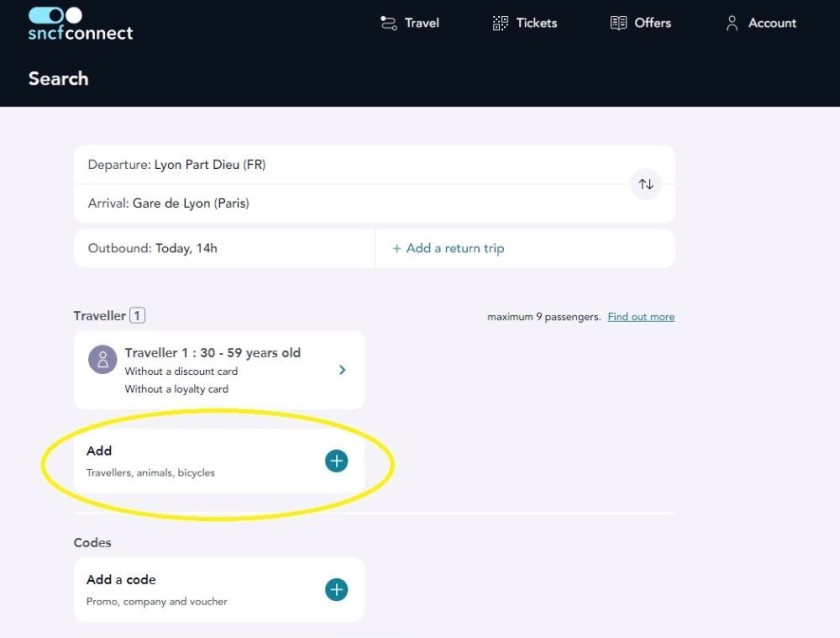
The usual travel ‘rules’ in France for folding bikes, bagged and placed on the floor by your seat, can also apply to standard bikes IF you can fit your bike in a bag measuring 120cm X 90cm max, by removing its front wheel and then by placing it and the rest of the bike in the bag.
If you CAN'T meet those requirements, the rules for taking a non-folding bike on a train vary according to both the type of travelling you will by AND in which region you will be travelling; though it is now much more likely than not, that you will be able to travel on French trains if you don't disassemble your bicycle.
What is particularly useful is that the recently launched national train ticket / travel ticket service, SNCF Connect, has incorporated the ability to add a wish to travel with a non-folding bicycle, into its journey search service.
So without buying a ticket, you can look up a journey and check which departures you can take a non-folding bike on board.
The ticket prices you will see for journeys by TGV and Intercités trains will include both your travel AND the bike’s; general info about booking French train tickets is available here.
Taking bikes on express trains in France:
You can take a non-folding bicycle on board Intercités trains for a flat fee of €5 regardless of the distance you will be travelling; and this price has recently been reduced by 50%.
For journeys by TGV, a recent changes is that a flat-rate reservation fee of €10 now covers journeys by any TGV InOui service, including the previously excluded double-deck TGV Duplex trains.
If you will be travelling by an Intercités, TGV Atlantique, TGV Duplex or TGV POS train, you usually have to interact with the train conductor, so when you’re at the station it’s worth checking what you’ll need to do.
Particularly if you won’t be joining a train at its starting point, so will have limited time on the voie (platform/track) to work out what the procedure is, when the train arrives.
However, the new TGV Oceane trains have been fitted with bike racks, so when you book a bike ticket on these trains, you will be reserving a space on the rack.
What’s also worth knowing is that you can’t book Premiére/1st class tickets for journeys by TGV or Intercités if you want to travel with a bike; presumably because the bike storage on these trains isn’t adjacent to the Premiére Class seating areas.
Taking a bike on regional trains in France:
In France the regional trains are the TER trains and most local train services outside of the Paris area are also classified as TER services.
You won’t need to purchase bike tickets for journeys by TER trains, but each region in France co-manages its TER trains with the national rail operator SNCF and the region can set certain stipulations, such as bikes not being allowed on trains at all at busy times.
Though what is universal is that when dedicated bike spaces are provided, they will be the only places on the train in which bikes can be stored and they're allocated on a first come, first served basis.
Meaning that you can't absolutely guarantee that space will be available for your bike(s); and many TER routes, particularly in rural areas, have gaps of two hours or more between departures.
Specific info is available by clicking the names of the regions on this list, though you'll need to use a translation facility if you can't read French - Auvergne-Rhone-Alpes; Bourgogne-Franche-Comte; Bretagne (Brittany); Centre val de Loire (the popularity of exploring the Loire Valley by bike has led to the creation of a special Train Velo Loire service, which can accommodate up to 83 bikes); Grand Est; Hauts De France; Normandy; Nouvelle Aquitaine; Occitaine; Pays de Loire and Provence-Alps-Cote d’Azur.
You can also take a bike on board a Transillien train, the longer-distance commuter routes to/from Paris EXCEPT when travelling on Monday to Friday between 6:30 - 9:30 and 16:30 - 19:30.
Notes on the ticketing:
On your ticket ‘voiture = the coach/carriage number, ‘Place Assise’ = the seat number.
Also have your passport (or another form of ID) with you on any journey including domestic journeys solely within France.
You need ID with you for ANY ticket to be valid.
Booking in advance online:
The earlier you can book journeys by Intercités and TGV InOui trains, the more money you can save.
That's because only limited numbers of the most heavily discounted tickets are made available on most routes taken by TGV and Intercités trains, but not by TER services.
Though on some routes by TER trains to and from Paris specific types of discounted tickets are available, but the saving is typically less than €10.
As the limited numbers of discounted tickets at the cheaper prices, inevitably sell out faster, the earlier you can book, the more likely it is that you will save money.
Tickets for journeys by Intercités and TGV InOui trains are now generally placed on sale up to 16 weeks ahead ahead; Though this period of time can be up to 7 months ahead on the routes from and to Paris Gare De Lyon.
In contrast tickets for Ouigo services are now typically available up to 6 months ahead!
If you look up journeys more than 16 weeks ahead on SNCF Connect, on routes shared by TGV InOui and Ouigo services, you will may only see the Ouigo departures listed; so in these circumstances, don't assume that travelling by a Ouigo service will be your only journey option.
SNCF will alert you to the fact that additional tickets will become available if you sign up for the notification service.
Introducing SNCF Connect:
SNCF Connect is the relatively new website for French rail tickets, hence ShowMeTheJourney's guide to what to look out for when making a booking.
Though some less obvious key features when booking on SNCF Connect, which are also different to the norm when booking European train tickets, are:
- For any journey in 2nd class on most French trains (Ouigo services are the exception) it isn't possible to choose between different types of ticket at the time of booking, only one type of ticket will be offered.
- It isn't possible to separate direct trains from journeys which involve connections.
- Journeys which involve more than two connections between trains (excluding transferring between stations in Paris) aren't available.
Saving money:
Aside from booking in advance for journeys by Intercités and TGV InOui trains, other money saving tips are:
- Ticket prices can be dependent on how popular a specific departure is likely to be, so different Intercites and InOui trains leaving the same day can be (much) cheaper than others.
- If you can book ahead, it's possible that tickets for the TGV InOui trains and Intercités may be cheaper than taking the TER trains, so you can have the option of getting to your destination faster AND saving money. TER train tickets can cost more than you might expect.
And if Ouigo trains are an alternative to the TGV InOui trains when making a high speed journey, you'll save money by taking a Ouigo.
Buying tickets at the station:
If you will be travelling by local or TER trains, tickets will typically cost the same price if you buy them last minute at the station.
However, when you buy a ticket(s) at the station it will be train service specific, meaning that if you buy a ticket that is valid for a journey by TER train services, you cannot then use on Intercités or TGV InOui trains.
All tickets* must be stamped at on the small yellow machines prior to boarding a train.
Normally these can be found at the entrance to a voie/track/platform.
*Tickets = tickets printed out by ticket machines or issued at ticket counters.
Seat reservations:
Reservations are compulsory for all journeys by TGV InOui trains, irrespective of whether the journey is on a high speed line, AND on some (but not all) Intercités trains.
The reservation will automatically be included, when booking tickets for journeys by these trains online; this also the case when booking tickets for Ouigo journeys
If you are booking 2nd class tickets for TGV InOui services you can choose the part of the train you would prefer to travel in.
However when booking 1st class tickets, you can also select specific seats from a seating plan; the more expensive of the two types of Ouigo tickets also enables the selection of specific seats.
Reservations are also mandatory on virtually all express trains to and from France including:
- on Eurostar,
- DB-SNCF
- Lyria,
- RENFE/SNCF,
- Thalys
- TGV France/Italy services
- the TGV trains between France and Belgium
The reservation will automatically be included when booking tickets for journeys by these trains.
Child tickets:
Children aged under 4 travel for free.
Children aged 4-11 pay half fare on all trains EXCEPT for Ouigo services, on which they travel at a flat rate of €5.
The adult rate is charged for all travellers aged 12 and over.
Detailed train ticket guides:
By train to and from Paris
There is no main central station in Paris instead the city is ringed by seven terminals.
Train services between Paris and destinations to the north depart from and arrive at the Gare Du Nord, while those between Paris and the south-east France use the Gare De Lyon.
The two stations are linked by frequent RER (commuter) trains.
However there are direct TGVs between Lille and many destinations served by trains to/from the Gare De Lyon, including Avignon, Lyon, Marseille and Montpellier.
Journeys from Paris
The journey guides include access to booking links and information about the trains, tickets and destination stations. Plus for the scenic routes there are insights on how to make the most of the rides on the trains.
Search for a journey:
A general note about the timetables:
French train timetables are often irregular, many specific train services/departures only operate on certain days of the week.
Also few train services operate at regular intervals; timetables on which trains leave at the same minutes passed every hour are comparatively usual in France.
Though what's becoming more common is that the same departure and arrival times are used on each day, but the train services can be travelling to and from different final destinations on different days of the week.
Meaning that the shorter the distance you will be travelling, the more likely it is that you will able to take trains leaving at regular intervals.
On TGV InOui routes the service can vary from a train every 30 mins at peak times, to gaps of two hours or more between trains in the middle of the day.
The longer distance regional TER trains also tend to operate to very sporadic timetables.
1 x train per hour is the exception rather than the norm; on many TER routes there can be gaps of 3-4 hours between trains.
The most scenic routes:
The most stunning journeys taken by long-distance trains are:
- Nimes <> Clermont Ferrand
- Marseille <> Toulon - Les Arcs > Nice
- Chambery <> Bourg St Maurice
- Beziers <> Clermont Ferrand
- Grenoble > Veynes > Marseille
- Chambery <> Modane
- Geneve <> Aix-les-Bains
- Geneve <> Bourg-en-Bresse
- Besancon <> Belfort (not the high speed line)
Other beautiful journeys by local and regional trains include:
- Toulouse <> La Tour de Carol
- Marseille <> Sausset-Les-Pins (the Cote Bleu route)
- Vallorcine > Chamonix - St Gervais
- Perpignan <> La Tour De Carol (not SNCF)
- Nice <> Cuneo
- Nice <> Digne (not SNCF)
- Nice <> Ventimglia
- Gap <> Briancon
- Perpignan <> Cerbere
Short videos showcasing some of these journeys have been uploaded to the ShowMeTheJourney channel on YouTube.
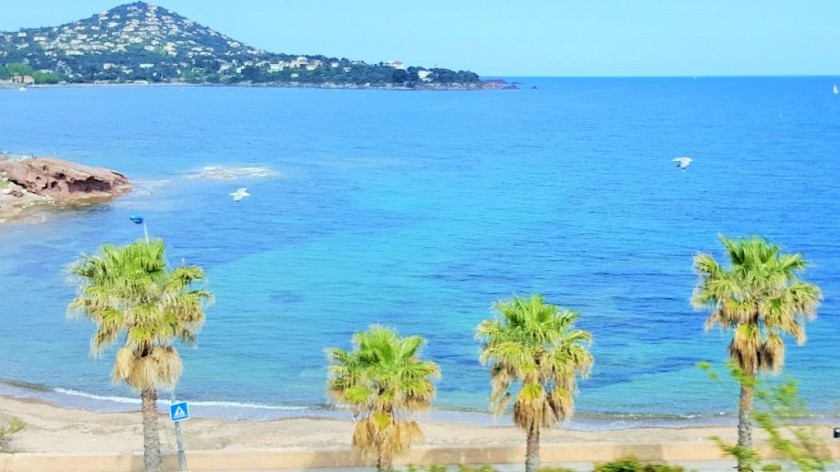
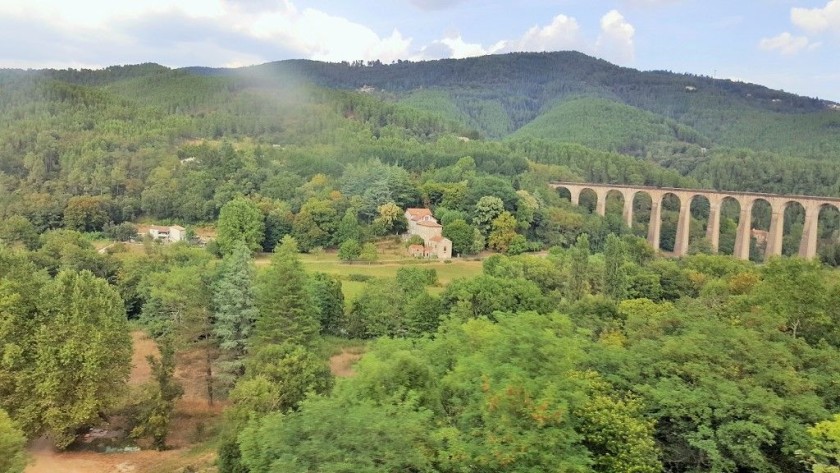
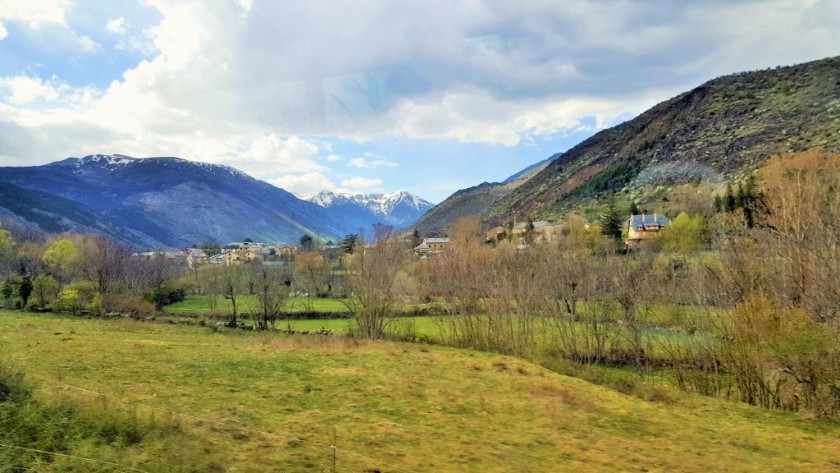
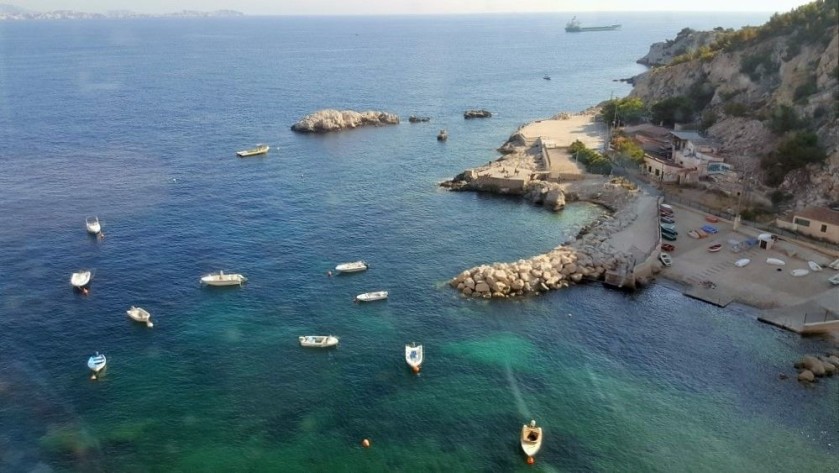
International rail routes from France:
Notes on using the major stations:
Most of the main stations in French cities are very evocative of how they were originally constructed back in the 19th century.
So they can be beautiful locations in which to wait for and board a train, but they weren't built to accommodate 21st century travel requirements.
As a result the access to and from the trains at some non-terminal stations can be comparatively awkward, because at this type of station, a passage beneath the tracks can be the only means of accessing many of the voies (platforms/tracks) which the trains depart from and arrive at.
And these passage ways are often not equipped with escalators or lifts (elevators); if they are provided at all, their use is restricted to travellers who require mobility assistance.
Meaning that staircasess can be the only means of transferring to and from the trains, at some or most of the platforms/tracks at many stations including Bordeaux St Jean, Dijon-Ville and Toulouse Matabiau.
More info, including how to find your way to your train, is available on the guide to using French train stations.
Good to know:
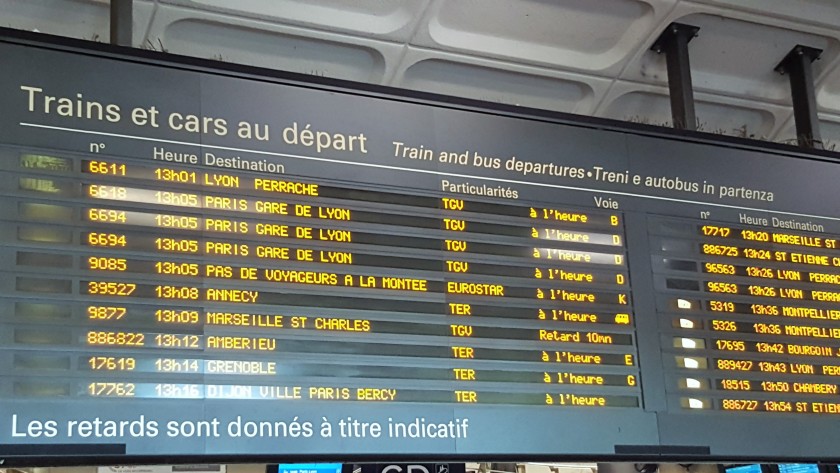
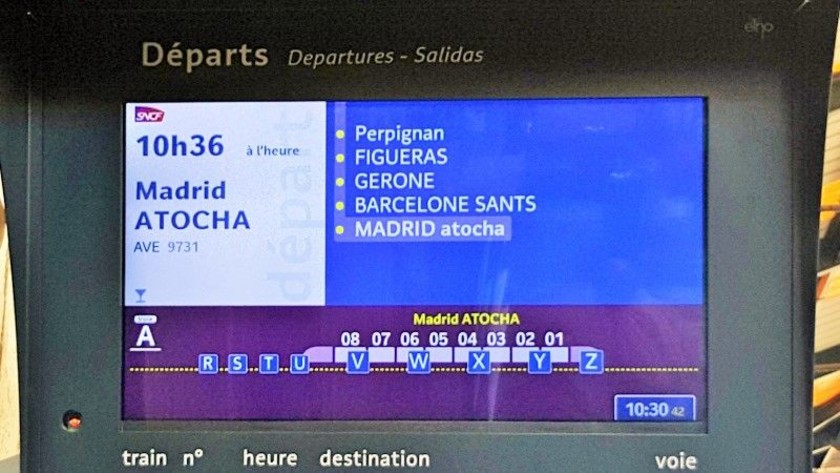
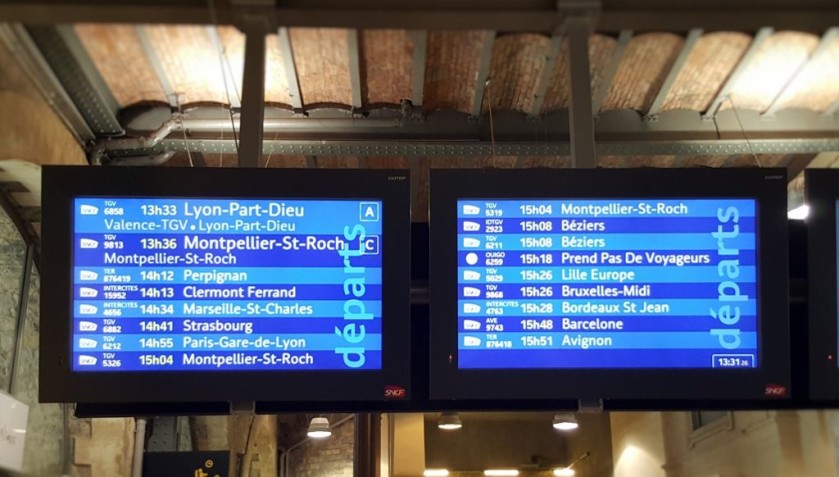
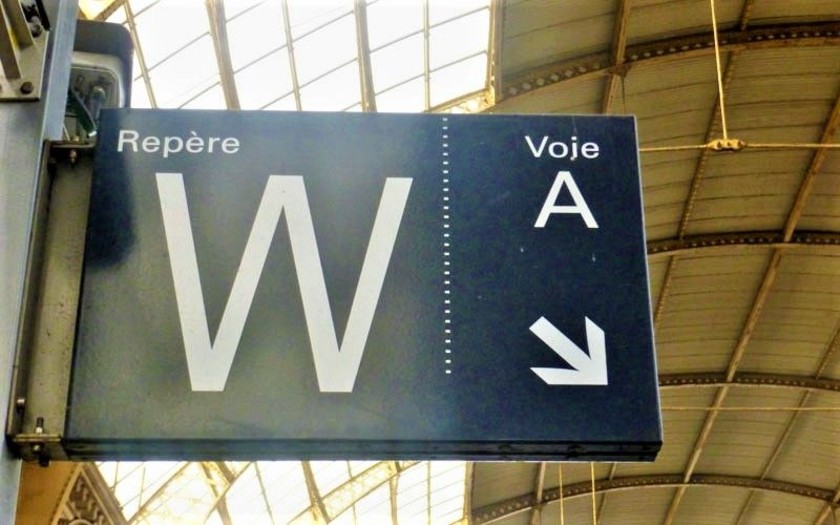
Eight things that are particularly good to know when using any major station in France.
1. 'Voie' = the platform/track.
2. The voie (platform/track) that an express train will depart from is divided into zones, a repére = a zone.
3. Letters and not numbers are used for each repére (zone), but at some major stations the voies (platforms/tracks) also have letters in place of numbers.
4. If you be will taking an Intercités or TGV service, for easy boarding when you are on the voie (platform/track) that your train will be leaving from, you can use the info screens to check which specific repére (zone) each 'voiture' (coach) will occupy.
This repére (zone) information is only usually available when you are on the voie (platform/track).
5. The number or letter of the specific voie (platform/track) that a train will be departing from will not usually be confirmed until 20 minutes before the departure time (though 30mins is the norm when taking a Ouigo service).
It may only be confirmed only 5 minutes in advance.
As a result the concourses at major stations can become crowded.
6. Because the voie (platform/track) is only confirmed so soon before departure, few major stations have departure sheets/posters.
If, for example, you want to check the return timings of a TER train, a good option is to pick up a pocket timetable for the route you will be taking, from a ticket office or 'Accueil' information desk.
7. However, not all 'Accueil' information desk staff will speak English.
8. All tickets* must be stamped at on the small yellow machines prior to boarding a train.
Normally these can be found at the entrance to a voie/track/platform.
*Tickets = tickets printed out by ticket machines or issued at ticket counters.
Left luggage:
French stations have staffed luggage offices, you need to process your bags and then having done so, you take them to a locker.
Therefore pay attention to the opening times when you drop off your luggage, you can only return and retrieve it at designated hours.
Only the following stations have left luggage lockers provided by the national rail company SNCF
- Bordeaux St-Jean
- Dijon-Vile
- Lille Europe
- Lyon Part Dieu
- Marne-la-Valley Chessy
- Marseille Saint-Charles
- Montpellier Saint-Roch
- Paris Gare du Nord
- Paris Gare de l'Est
- Paris Gare de Lyon
- Paris Montparnasse
- Paris Austerlitz
- Strasbourg
- Toulouse Matabiau
At other locations the left luggage facilities can be provided within the station or in its neighbourhood, by Nannybag.
First Class lounges
Those who have booked Business Premiere tickets to travel on the TGV InOui trains can access Grand Voyageur lounges - Though they are only available at these stations: Paris Est; Paris Nord; Paris Montparnasse; Paris Gare de Lyon; Bordeaux-St Jean; Lille-Europe; Lille-Flandres; Lyon-Part Dieu; Marseille-St Charles; Nantes, Rennes and Strasbourg.
Detailed info on the major stations
Click the buttons below to discover how to travel to and from the stations by public transport, plus links to additional info including the station and city websites.
Please support ShowMeTheJourney
This second version of ShowMeTheJourney is exciting and new, so we are genuinely thrilled that you are here and reading this, but we also need your help.
We’re striving not to let anything get in the way of providing the most useful service possible, hence a facility has been set up with DonorBox which can be used to support the running costs and make improvements.
Instead of advertising or paywalls, your financial support will make a positive difference to delivering an enhanced service, as there’s a lot of ideas which we want to make happen.
So if you have found the info provided here to be useful, please go here to say thank you.
Other travel guides
These guides all contain info relevant to French train travel, so dive in and discover more about how to explore France by train.
This second version of ShowMeTheJourney is exciting and new, so we are genuinely thrilled that you are here and reading this, but we also need your help.
We’re striving not to let anything get in the way of providing the most useful service possible, hence a facility has been set up with DonorBox which can be used to support the running costs and make improvements.
Instead of advertising or paywalls, your financial support will make a positive difference to delivering an enhanced service, as there’s a lot of ideas which we want to make happen.
So if you have found the info provided here to be useful, please consider saying thank you.
See if there’s a unique journey guide for your trip, featuring info on the trains, tickets & stations.

This is one of more than 100 train travel guides available on ShowMeTheJourney, which will make it easier to take the train journeys you want or need to make. As always, all images were captured on trips taken by ShowMeTheJourney.








